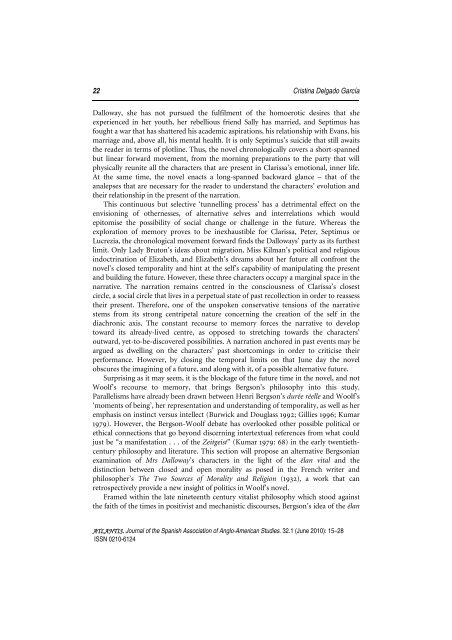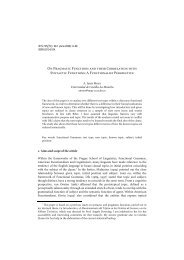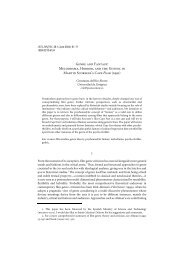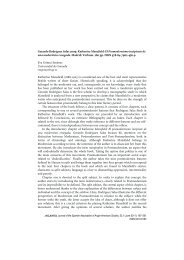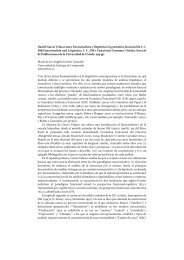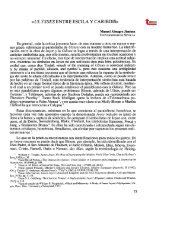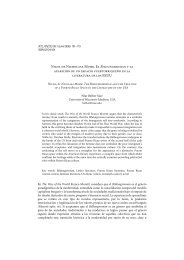Revista de la Asociación Española de Estudios Anglo - Atlantis
Revista de la Asociación Española de Estudios Anglo - Atlantis
Revista de la Asociación Española de Estudios Anglo - Atlantis
Create successful ePaper yourself
Turn your PDF publications into a flip-book with our unique Google optimized e-Paper software.
22 Cristina Delgado García<br />
Dalloway, she has not pursued the fulfilment of the homoerotic <strong>de</strong>sires that she<br />
experienced in her youth, her rebellious friend Sally has married, and Septimus has<br />
fought a war that has shattered his aca<strong>de</strong>mic aspirations, his re<strong>la</strong>tionship with Evans, his<br />
marriage and, above all, his mental health. It is only Septimus’s suici<strong>de</strong> that still awaits<br />
the rea<strong>de</strong>r in terms of plotline. Thus, the novel chronologically covers a short-spanned<br />
but linear forward movement, from the morning preparations to the party that will<br />
physically reunite all the characters that are present in C<strong>la</strong>rissa’s emotional, inner life.<br />
At the same time, the novel enacts a long-spanned backward g<strong>la</strong>nce – that of the<br />
analepses that are necessary for the rea<strong>de</strong>r to un<strong>de</strong>rstand the characters’ evolution and<br />
their re<strong>la</strong>tionship in the present of the narration.<br />
This continuous but selective ‘tunnelling process’ has a <strong>de</strong>trimental effect on the<br />
envisioning of othernesses, of alternative selves and interre<strong>la</strong>tions which would<br />
epitomise the possibility of social change or challenge in the future. Whereas the<br />
exploration of memory proves to be inexhaustible for C<strong>la</strong>rissa, Peter, Septimus or<br />
Lucrezia, the chronological movement forward finds the Dalloways’ party as its furthest<br />
limit. Only Lady Bruton’s i<strong>de</strong>as about migration, Miss Kilman’s political and religious<br />
indoctrination of Elizabeth, and Elizabeth’s dreams about her future all confront the<br />
novel’s closed temporality and hint at the self’s capability of manipu<strong>la</strong>ting the present<br />
and building the future. However, these three characters occupy a marginal space in the<br />
narrative. The narration remains centred in the consciousness of C<strong>la</strong>rissa’s closest<br />
circle, a social circle that lives in a perpetual state of past recollection in or<strong>de</strong>r to reassess<br />
their present. Therefore, one of the unspoken conservative tensions of the narrative<br />
stems from its strong centripetal nature concerning the creation of the self in the<br />
diachronic axis. The constant recourse to memory forces the narrative to <strong>de</strong>velop<br />
toward its already-lived centre, as opposed to stretching towards the characters’<br />
outward, yet-to-be-discovered possibilities. A narration anchored in past events may be<br />
argued as dwelling on the characters’ past shortcomings in or<strong>de</strong>r to criticise their<br />
performance. However, by closing the temporal limits on that June day the novel<br />
obscures the imagining of a future, and along with it, of a possible alternative future.<br />
Surprising as it may seem, it is the blockage of the future time in the novel, and not<br />
Woolf’s recourse to memory, that brings Bergson’s philosophy into this study.<br />
Parallelisms have already been drawn between Henri Bergson’s durée réelle and Woolf’s<br />
‘moments of being’, her representation and un<strong>de</strong>rstanding of temporality, as well as her<br />
emphasis on instinct versus intellect (Burwick and Doug<strong>la</strong>ss 1992; Gillies 1996; Kumar<br />
1979). However, the Bergson-Woolf <strong>de</strong>bate has overlooked other possible political or<br />
ethical connections that go beyond discerning intertextual references from what could<br />
just be “a manifestation . . . of the Zeitgeist” (Kumar 1979: 68) in the early twentiethcentury<br />
philosophy and literature. This section will propose an alternative Bergsonian<br />
examination of Mrs Dalloway’s characters in the light of the é<strong>la</strong>n vital and the<br />
distinction between closed and open morality as posed in the French writer and<br />
philosopher’s The Two Sources of Morality and Religion (1932), a work that can<br />
retrospectively provi<strong>de</strong> a new insight of politics in Woolf’s novel.<br />
Framed within the <strong>la</strong>te nineteenth century vitalist philosophy which stood against<br />
the faith of the times in positivist and mechanistic discourses, Bergson’s i<strong>de</strong>a of the é<strong>la</strong>n<br />
ATLANTIS. Journal of the Spanish Association of <strong>Anglo</strong>-American Studies. 32.1 (June 2010): 15–28<br />
ISSN 0210-6124


